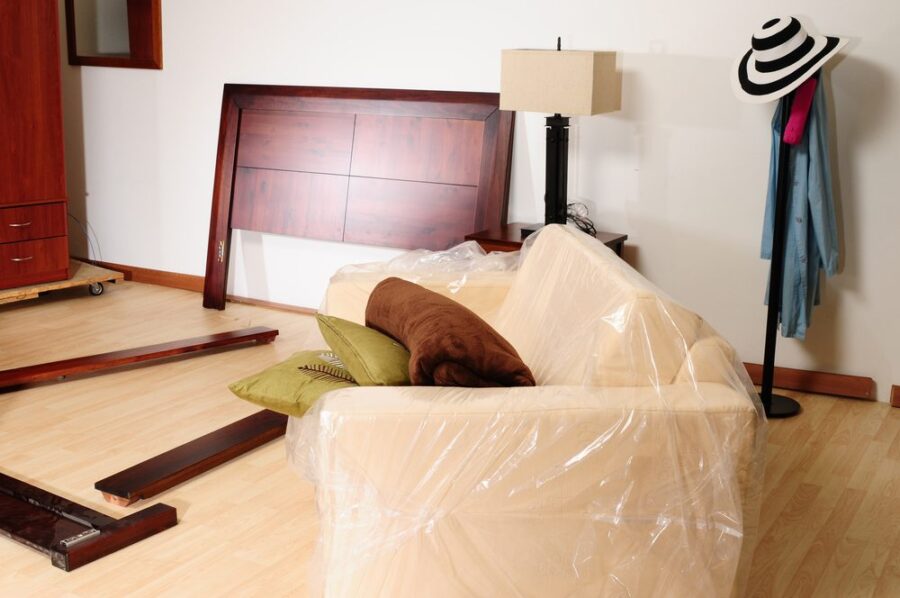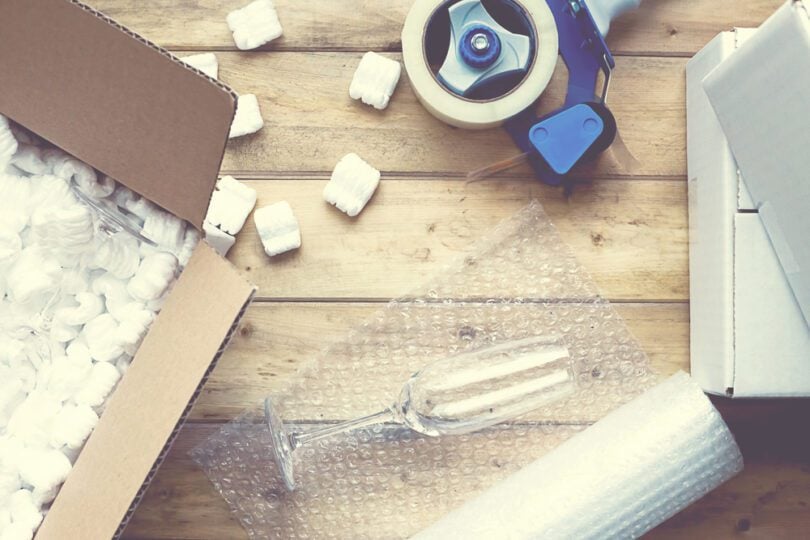Moving isn’t just stuffing boxes with clothes and packing up that VHS collection you forgot was in the crawlspace. When moving day comes, you’ll have to shift a lot of items that require some extra care.
Moving large or fragile items requires special know-how to ensure they – and you – are safe in transit. Moving large items incorrectly can damage them and put a strain on your body. Fragile items should be safely packed to ensure they arrive in the same condition they left. With a few simple tips, you’ll save time, energy, and the stress of “hoping” everything will remain intact!

Moving large or fragile items? Here’s everything you need to know:
Packing Fragile Items
When it comes to packing fragile items, you need to give some special attention to how you pack them. Where things like books and clothes are packed for the sake of packing them, the true consideration for fragile items is whether they’ll be safe and secure in transit.

Here are a few tips for packing some common fragile items:
- Consider using dish boxes for your plates, and packing them vertically. This reduces the surface area and lowers the risk of plates at the bottom being crushed by the weight of those above. Wrap individual plates in bubble wrap, and consider a box fit for the purpose with dividers to separate each plate.
- There are also specialty boxes for glasses (including wine glasses or champagne flutes) with dividers between each glass. This ensures each is protected from friction or clashing, and glasses stand upright in the box.
- Fill glasses with packing paper to soften vibrations while in motion.
- To protect fragile loose items, wrap each individually with packing paper and/or bubble wrap. In cases where items have multiple pieces such as a teapot with a lid, wrap items separately.
Moving Fragile Items
Preparing to move large or fragile items are of course two critical but very different elements of your move. Let’s start with moving fragile items, and some key tips.
Give Yourself Time
The best way to be sure you’re packing your fragile items with the utmost care is to take your time. “Haste makes waste” as they say, so start early and don’t rush. Collect your fragile items and understand what you need to do to ensure they’re packed carefully for transport.
Wrap items individually in paper, towels, or bubble wrap. Pay attention to not only the wrapping but placement of items in boxes. Take care that they won’t shift too much, or clash against one another if lightly wrapped.
Stock Up on Supplies
Make sure you have plenty of supplies to pack your items well. Bubble wrap and rolls of packing paper are a great start. If you have rags, towels, linens, and other fabrics that can be used to wrap or pad your fragile items these are great (and green) alternatives.
You’ll likely also need tape and of course boxes or containers to pack them into. There are boxes designed specifically for cups or dishes to help you with the task of moving your kitchen.

Consider what else may need special boxes or materials. If you’re moving a television hopefully you have the box. If not, track down a TV box to protect the electronics and the screen in transit. Even if you have the box you likely don’t still have the styrofoam packing for your TV, stereo, computer monitor, or other fragile electronics. Make sure you start early and pad well – particularly the corners which can be more prone to shock or bumps.
Label Everything
Don’t take for granted that you’ll remember just what is where when moving day comes. And don’t assume that every box will be handled with delicate care regardless of labels.
Label your fragile boxes with – you guessed it – “FRAGILE”. This not only helps with shifting the boxes but ensuring your book collection isn’t rested on top of your grandmother’s fine china. It’s great to also take a moment to list briefly just what’s in your boxes so you can keep track along the way. This of course goes for your non-fragile items as well, so you can make sure everything is moved and transported in the best way and that your boxes arrive at the right place in your new home.
Moving Large Items
Moving large items also takes some planning, but the requirements are much different of course. Here are some tips on moving large items:
The Smaller the Better
The best place to start is by evaluating what can be disassembled. Breaking things down into smaller pieces is a huge help when moving large items. Not only will it help you to lift, shift, and navigate the movement of the items, it will save you some physical strain.

Label screws, bolts, and individual pieces of furniture when you disassemble it. The same goes for taking photos of wire connections on stereo systems and entertainment centers. Future You will thank you on the other side – trust us.
More than that, be sure to empty drawers and shelves to lighten your load. While leaving clothes in drawers can save you time in packing, if they’re full of books or your wool sweaters and coats, they can get heavy.
Think Practically
This is the part where we help you avoid those moments trying to wedge (or un-wedge) furniture through a doorway. Think ahead, and consider the practicalities. Consider the path you’ll need to take to get each item out of the house and onto the moving truck. Then, break out the tape measure.
Measure your item as well as any doorways or corners in hallways. Make sure you can smoothly navigate with things as-is. If not you may have to remove your door from its hinges.
Practicalities also involved how many hands – and strong arms – you’ll need to move your items. If you’ll need help, ask early. Avoid scrambling, begging, and bribing helpers to join you in shifting large and heavy items.
The most reliable and stress-saving option, of course, is to hire a professional moving company. They have all of the equipment necessary to lift and shift your items and will even disassemble and reassemble your furniture for you.
Use Protection
There are a variety of furniture pads and blankets available, and for good reason. No matter how careful you intend to be, it can be challenging to move big items. Not only that, it can be hard to anchor them in the moving truck to avoid shifting.

To protect from damage make sure you use what’s available to you. Furniture blankets, blankets and thick linens, pads, bubble wrap, and more will help put your mind – and furniture – at ease.








